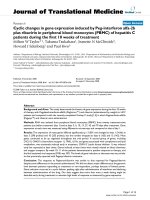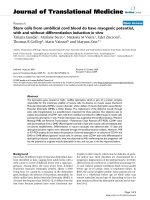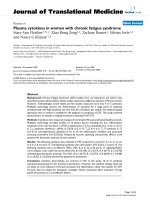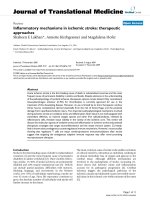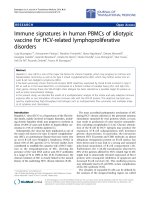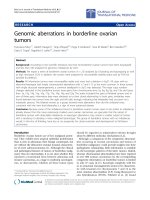báo cáo hóa học:" Dynamic splinting in wrist extension following distal radius fractures" pot
Bạn đang xem bản rút gọn của tài liệu. Xem và tải ngay bản đầy đủ của tài liệu tại đây (387.37 KB, 4 trang )
RESEA R C H ART I C L E Open Access
Dynamic splinting in wrist extension following
distal radius fractures
Stacey H Berner
1
, F Buck Willis
2*
Abstract
Background: Wrist flexion contracture is a common pathology which presents secondary to dis tal radius fractures .
Joint stability, restoration and early mobilization are frequently achieved through surgical treatment after such an
injury. The purpose of this retrospective study was to evaluate the initial effect of dynamic splinting on wrist
extension (active range of motion), in both surgical and non-surgical patients following distal radius fractures.
Methods: Records were obtained from 133 patients who were treated with a Wrist Extension Dynasplint (WED)
following distal radius fractures, between May 2007 and May 2009. Forty-two of these patients received surgical
treatment for their fracture s. This study specifically examined the initial usage of the WED as a home therapy. The
retrospective analysis included categorization of patients who received the WED exclusively vs. patients who
received WED treatment with concurrent hand therapy; surgical categorization included surgical patients vs.
nonsurgical patients.
Results: There was a significant improvement in maximal active range of motion (AROM) for all patients (P <
0.0001) after a mean duration of 3.9 weeks of dynamic splinting. Patients showed a mean 62% increase in active
extension. There was not a significant difference between patients who had received surgical treatment for the
fracture vs. nonsurgical.
Conclusion: This dynamic splinting modality contributed 138 to 185 hours of stretching at the end range of
motion for these patients in their first month following fracture. This unique regime is considered directly
responsible for significant gains in AROM.
Introduction
Contracture is seen commonly following Distal Radius
Fractures (DRF), and surgical management is being used
on an increasing number of DRF patients [1,2]. Greater
frequency of surgical procedures may come from the
desire to help patients restore stability, correct articular
malalignment, and regain mobility more expediently [3-7].
Patient satisfaction through increased joint mobility
has been the primary outcome measure in numerous
studies that examined the current therapeutic protocols
for treating DRF [8-13] and protocols supplemented
with prolonged durations of therapeutic str etching
[14-19]. Franco et al conducted a randomized, cross-
over, cohort study of 45 asymptomatic patients treated
with static splints (which re stricts mobility similar to
immobilization) [4]. After treatment in a restrictive, sta-
tic splint, Franco et al concluded that immobilization
creates incrementally significant functional limitations.
Prolonged stretching has been shown to have a signifi-
cant effect on connective tissue in molecular examina-
tion [17] and clinical trials [18,19]. Dynamic splinting
employs passive, prolonged stretching which has pro ven
responsible for contracture reduction in other joints and
pathologies [13-16]. The purpose of this retrospective
study was to evaluate the initial effect of dynamic splint-
ing on wrist extension (active range of motion), in both
surgical and non-surgical patients following distal radius
fractures.
Materials and methods
Patients
This retrospective study examined the records of 133
DRF patients (78 women, 55 men; mean age 53 ± 17.6)
* Correspondence:
2
University of Phoenix: Axia College; Health Sciences, Adjunct Instructor and
Dynasplint Systems, Inc, Clinical Research, PO Box 1735 San Marcos TX
78667, USA
Full list of author information is available at the end of the article
Berner and Willis Journal of Orthopaedic Surgery and Research 2010, 5:53
/>© 2010 Berner and Wil lis; licensee BioMed Central Ltd. This is an Open Access article distributed und er the terms of the Creative
Commons Attr ibution License ( ), which permits unrestricted use, distribution, and
reproduction in any medium, provided the original work is properly cited.
who were treated with dynamic splinting for contracture
reduction following distal radius fractures. Forty-two of
these patients received this treatment follow ing surgical
management of DRF. All patients treated with this mod-
alitywerefitwithinoneweekofthediagnosisofwrist
flexion contracture, secondary to DRF. Patients were
prescribed nightly use of the dynamic splinting modality.
(All patients gave informed consent for use of their
records in this retrospective study.) See demographics in
Table 1.
Intervention
Patients’ initial introduction to the Wrist Extension
Dynasplint (WED) system, [Dynasplint Systems, Inc.,
Severna Park, MD, USA] included customized fitting
(wrist length, width, and girth so that the force and
counter force straps could be properly aligned) and
training on donning and doffing of the device. (See
figure 1.) V erbal and written instructions were provided
throughout the duration of treatment for safety, general
wear an d care, and t ension setting goal s based on
patient tolerance.
Each patient initially wore the WED for 4-6 continu-
ous hours at an initial tensionsettingof#2(0.1foot
pounds of torque). This duration was for acclimatization
to the system; then patients were instructed to wear the
WED system at night while sleeping for 6-8 hours of
continuous wear. After each patient was comfortable
wearing the unit for one week at tension level #2, they
were instructed to increase the tension level to #3 (0.3 ft
lbs.) and make continual increases every two weeks. If
prolonged soreness fo llowed a session (soreness for
more than 15 minutes) the patient was instructed to
decrease the tension one half a setting for two days
until they were comfortable wearing it for 6-8 hours at
the new tension setting. The majority of all patients
reached level #5 (0.8 foot pounds of torque) by the end
of two months. All range of motion measurements were
recorded by the prescribing clinician.
Statistical Methods
The dependent variable in this study was the change in
wrist extension AROM and the independent variables
were the patient treatment categories, post surgical vs.
non surgical and concurrent physical therapy plus WED
vs. exclusive WED treatment. Statistical data analysis
was accomplished using a repeated measures analysis of
var ian ce (ANOVA) with Post-hoc T-tests. Data analysis
was done independently by Dr. Ram Shanmugam, a
biostatistics professor at Texas State Univer sity, San
Marcos, TX.
Results
There was a significant improvement in motion for all
patients (P = 0.0001, T = 10.126, df 132; see figure 2).
The mean increase was 16° AROM for all patients
(SD 2.1). A normal statistical distribution of data was
seen in both the initial AROM measurements and the
final AROM, and these measurements were highly cor-
related. There was not a significant difference between
patients who received previous surgical treatment or
Physical Therapy (PT) plus WED, (74% PT+WED,
N = 10 1, P > 0.05). The results showed no significant
difference among gender or in the duration between
fracture and WED treatment (Mean 3.9 weeks, Range
3-20 weeks, SD = 3.87, P > 0.05).
Discussion
This modality was responsible for regaining 62%
increased active range of motion which will directly
affect function. The efficacy of dynamic splinting for
contracture reduction was simila r to r esults from the
Carpal Tunnel study by Berner and Willis. The results
of that study showed efficacy of dynamic splinting in
reducing symptoms from carpal tunnel syndrome [15].
The outcome measured changes in Levine-Katz func-
tion/painsurveyandnerveconduction,whichshowed
statistically significant differences [15] The benefits of
WED in this retrospective cohort study were compar-
able to results seen in a case report on dynamic splint-
ing for contracture following radial nerve injury [13].
McKee and Nguyen’ s case described a 76 year old
patient who suffered a radial nerve injury following a
shoulder replacement. They found that dynamic splint-
ing he lped this patient regain motor functions that were
previously disabled by the excessive wrist flexion con-
tracture [13]. Molecular analysis has proven prolonged
stretching responsible for connective tissue elongation
[14-16], as employed in dynamic splinting.
The lack of difference between surgical patients vs.
non surgical patients supports the hypothesis that con-
tracture was caused by the combined effect of the distal
radius fracture and the associated soft tissue injury. Sev-
eral manuscripts have recommended studies examine
Table 1 Demographics
Parameter n
Total Patients 133
Surgical Patients (%) 42 (31.6%)
Age (yrs) 53 ± 17.6
Female (%) 78 (58.6%)
Pts who had Physical Therapy (%) 54 (40.6%)
White (%) 88%
Other (%) 6%
Black (%) 2%
Hispanic (%) 4%
Berner and Willis Journal of Orthopaedic Surgery and Research 2010, 5:53
/>Page 2 of 4
increases in function following treatment for a distal
radius fracture [1-3]. The duration of WED treat ment
ranged from 3 to 20 weeks and the mean duration may
be skewed because of patients who discontinued using
the WED in less than two months, after full ROM was
restored.
The physical therapists were not blinded so their
methods included the WED as the primary stretching
protocol; therefore the therapists spent more time on
higher therap eutic protoco ls for weight bearing, load
bea ring, and dexterity. Time saved in manual stretching
due to the assistance of the dynamic splint was often
dedicated to motor dexterity training for handwriting.
Since there was not a significant difference with physical
therapy, each surgeon should examine the specific
needs. In this study the Medicare co-payment for each
patient included $20/mo for the WE D vs. $200 to $500/
mo in co-payments for PT 3/wk. That savings would be
substantial for the patients and insurance providers.
The limitations of this study i nclude lack of a control
arm. While duration from fracture t o contracture wa s
not categorized, all patients were fit with WED within
one week from diagnosis of wrist flexion contr acture,
secondary to DRF. Clinicians often discredit case series
Figure 1 Wrist Extension Dynasplint.
Figure 2 Results.
Berner and Willis Journal of Orthopaedic Surgery and Research 2010, 5:53
/>Page 3 of 4
manuscripts because such studies lack control group(s)
and can have selection bias. However, this study did
examine different cohort treatment groups (surgical vs.
nonsurgical and physical therapy with dynamic splinting
vs. exclusive dynamic splinting) [20]. This study was
independent of “measurement bias ” because all mea-
surements used in data analysis were taken by clinicians,
before initiation of this retrospective investigation.
Kooistra et al wrote a detailed description of the
strengths and weaknesses of Case Series studies where
they described that such studies can effectivel y generate
a hypothesis for future controlled trials and prove safety
of a new protocol [20]. They also described that a retro-
spective design more clearly reflects what is seen in rou-
tine clinical practice because treatment selection was
chosen by the surgeon and patient, not by a randomized
table. This fact is the cornerstone to their proclamation
that retrospective cohort series studies have high exter-
nal validity [20].
This retrospective study on WED for contracture
reduction, secondary to DRF showed safety as there was
only 1 in 133 incidence of skin breakdown and no
report of significant adverse events from these treat-
ments. This study was the first investigati on of dynamic
splinting for contracture reduction following distal
radius fractures, and the authors recomme nd this work
be followed by a randomized, controlled trial to measure
empirical efficacy of this modality in contracture
reduction.
Acknowledgements
The authors wish to thank Dr Willis’ assistant Brook Fowler, CCRP for her
efforts in coordinating confidential patient records and manuscript reviews.
Author details
1
Advanced Centers for Orthopaedic Surgery & Sports Medicine, 10
Crossroads #210 Owings Mills, MD 21117, USA.
2
University of Phoenix: Axia
College; Health Sciences, Adjunct Instructor and Dynasplint Systems, Inc,
Clinical Research, PO Box 1735 San Marcos TX 78667, USA.
Authors’ contributions
All authors contributed equally to this work. SHB and FBW both participated
in the design
of the study and manuscript. FBW was responsible for the literature review
and manuscript development. The data analysis was done independent ly by
a biostatistical professor for Texas State University, Dr Ram Shanmugam. All
authors read and approved the final manuscript.
Competing interests
There was no extramural funding for this study. SHB had no conflict or
competing interest, and has not received any funds or compensation for his
participation in this study. FBW is employed by the parent company of
Dynasplint Systems but he has no stock, options, or ownership in either
company.
Received: 5 January 2010 Accepted: 6 August 2010
Published: 6 August 2010
References
1. Fanuele J, Koval KJ, Lurie J, Zhou W, Tosteson A, Ring D: Distal radial
fracture treatment: what you get may depend on your age and address.
J Bone Joint Surg Am 2009, 91(6):1313-9.
2. Koval KJ, Harrast JJ, Anglen JO, Weinstein JN: Fractures of the distal part of
the radius. The evolution of practice over time. Where’s the evidence? J
Bone Joint Surg Am 2008, 90(9):1855-61.
3. Lucado AM, Li Z, Russell GB, Papadonikolakis A, Ruch DS: Changes in
impairment and function after static progressive splinting for stiffness
after distal radius fracture. J Hand Ther 2008, 21(4):319-25.
4. Franko OI, Zurakowski D, Day CS: Functional disability of the wrist: direct
correlation with decreased wrist motion. J Hand Surg [Am] 2008,
33(4):485-92.
5. Nagy L: Salvage of post-traumatic arthritis following distal radius
fracture. Hand Clin 2005, 21(3):489-98, Handoll HH, Huntley JS, Madhok R.
Different methods of external fixation for treating distal radial fractures in
adults. Cochrane Database Syst Rev. 2008 Jan 23;(1):CD006522.
6. Lutz M, Rudisch A, Kralinger F, Smekal V, Goebel G, Gabl M, Pechlaner S:
Sagittal wrist motion of carpal bones following intraarticular fractures of
the distal radius. J Hand Surg [Br] 2005, 30(3):282-7, Epub 2005 Apr 8.
7. Rein S, Schikore H, Schneiders W, Amlang M, Zwipp H: Results of dorsal or
volar plate fixation of AO type C3 distal radius fractures: a retrospective
study. J Hand Surg [Am] 2007, 32(7):954-61.
8. Chung KC, Haas A: Relationship between Patient Satisfaction and
Objective Functional Outcome after Surgical Treatment for Distal Radius
Fractures. J Hand Ther 2009, 22(4):302-7, quiz 308. Epub 2009 Jun 26.
9. Wilcke MK, Abbaszadegan H, Adolphson PY: Patient-perceived outcome
after displaced distal radius fractures. A comparison between
radiological parameters, objective physical variables, and the DASH
score. J Hand Ther 2007, 20(4):290-8.
10. Shin EK, Jupiter JB: Current concepts in the management of distal radius
fractures. Acta Chir Orthop Traumatol Cech 2007, 74(4):233-46.
11. Watt CF, Taylor NF, Baskus K: Do Colles’ fracture patients benefit from
routine referral to physiotherapy following cast removal? Arch Orthop
Trauma Surg 2000, 120(7-8):413-5.
12. Maciel JS, Taylor NF, McIlveen C: A randomised clinical trial of activity-
focussed physiotherapy on patients with distal radius fractures. Arch
Orthop Trauma Surg 2005, 125(8):515-20, Epub 2005 Oct 22.
13. McKee P, Nguyen C: Customized dynamic splinting: orthoses that
promote optimal function and recovery after radial nerve injury: a case
report. J Hand Ther 2007, 20(1):73-87.
14. Willis B, Gaspar P, Neffendorf C: Device and Physical Therapy to Unfreeze
Shoulder Motion.
BioMechanics 2007, 14(1):45-49.
15. Berner SH, Willis FB: Treatment of Carpal Tunnel Syndrome with
Dynasplint: a Randomized, Controlled Trial. Journal of Medicine 2008,
1(1):90-94.
16. Lai JM, Francisco GE, Willis FB: Dynamic splinting after treatment with
botulinum toxin type-A: A randomized controlled pilot study. Adv Ther
2009, 26(2):241-8, Epub 2009 Feb 4.
17. Avela J, Kyröläinen H, Komi PV: Altered reflex sensitivity after repeated
and prolonged passive muscle stretching. J Appl Physiol 1999,
86(4):1283-91.
18. Abellaneda S, Guissard N, Duchateau J: The relative lengthening of the
myotendinous structures in the medial gastrocnemius during passive
stretching differs among individuals. J Appl Physiol 2009, 106(1):169-77.
19. Usuba M, Akai M, Shirasaki Y, Miyakawa S: Experimental joint contracture
correction with low torque, long duration repeated stretching. Clin
Orthop Relat Res 2007, 456:70-8.
20. Kooistra B, Dijkman B, Einhorn TA, Bhandari M: How to design a good case
series. J Bone Joint Surg [Am] 2009, 91(Suppl 3):21-6.
doi:10.1186/1749-799X-5-53
Cite this article as: Berner and Willis: Dynamic splinting in wrist
extension following distal radius fractures. Journal of Orthopaedic Surgery
and Research 2010 5:53.
Berner and Willis Journal of Orthopaedic Surgery and Research 2010, 5:53
/>Page 4 of 4
